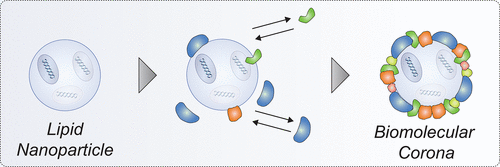当前位置:
X-MOL 学术
›
Bioconjugate Chem.
›
论文详情
Our official English website, www.x-mol.net, welcomes your feedback! (Note: you will need to create a separate account there.)
The Biomolecular Corona of Lipid Nanoparticles for Gene Therapy.
Bioconjugate Chemistry ( IF 4.7 ) Pub Date : 2020-08-07 , DOI: 10.1021/acs.bioconjchem.0c00366 Valentina Francia 1, 2 , Raymond M Schiffelers 2 , Pieter R Cullis 1, 3 , Dominik Witzigmann 1, 3
Bioconjugate Chemistry ( IF 4.7 ) Pub Date : 2020-08-07 , DOI: 10.1021/acs.bioconjchem.0c00366 Valentina Francia 1, 2 , Raymond M Schiffelers 2 , Pieter R Cullis 1, 3 , Dominik Witzigmann 1, 3
Affiliation

|
Gene therapy holds great potential for treating almost any disease by gene silencing, protein expression, or gene correction. To efficiently deliver the nucleic acid payload to its target tissue, the genetic material needs to be combined with a delivery platform. Lipid nanoparticles (LNPs) have proven to be excellent delivery vectors for gene therapy and are increasingly entering into routine clinical practice. Over the past two decades, the optimization of LNP formulations for nucleic acid delivery has led to a well-established body of knowledge culminating in the first-ever RNA interference therapeutic using LNP technology, i.e., Onpattro, and many more in clinical development to deliver various nucleic acid payloads. Screening a lipid library in vivo for optimal gene silencing potency in hepatocytes resulted in the identification of the Onpattro formulation. Subsequent studies discovered that the key to Onpattro’s liver tropism is its ability to form a specific “biomolecular corona”. In fact, apolipoprotein E (ApoE), among other proteins, adsorbed to the LNP surface enables specific hepatocyte targeting. This proof-of-principle example demonstrates the use of the biomolecular corona for targeting specific receptors and cells, thereby opening up the road to rationally designing LNPs. To date, however, only a few studies have explored in detail the corona of LNPs, and how to efficiently modulate the corona remains poorly understood. In this review, we summarize recent discoveries about the biomolecular corona, expanding the knowledge gained with other nanoparticles to LNPs for nucleic acid delivery. In particular, we address how particle stability, biodistribution, and targeting of LNPs can be influenced by the biological environment. Onpattro is used as a case study to describe both the successful development of an LNP formulation for gene therapy and the key influence of the biological environment. Moreover, we outline the techniques available to isolate and analyze the corona of LNPs, and we highlight their advantages and drawbacks. Finally, we discuss possible implications of the biomolecular corona for LNP delivery and we examine the potential of exploiting the corona as a targeting strategy beyond the liver to develop next-generation gene therapies.
中文翻译:

脂质纳米颗粒的生物分子电晕基因治疗。
基因疗法具有通过基因沉默,蛋白质表达或基因校正来治疗几乎任何疾病的巨大潜力。为了有效地将核酸有效载荷递送至其靶组织,遗传物质需要与递送平台结合。脂质纳米颗粒(LNPs)已被证明是基因治疗的出色载体,并且正日益进入常规临床实践。在过去的二十年中,用于核酸递送的LNP配方的优化已导致建立了广泛的知识体系,最终形成了使用LNP技术(即Onpattro)的首个RNA干扰治疗剂,以及更多的临床开发方法各种核酸有效载荷。体内筛选脂质库肝细胞中最佳的基因沉默效能的鉴定导致了Onpattro制剂的鉴定。随后的研究发现,Onpattro肝脏趋向性的关键在于其形成特定“生物分子电晕”的能力。实际上,除其他蛋白外,载于LNP表面的载脂蛋白E(ApoE)可以特异性靶向肝细胞。这个原理证明的例子证明了使用生物分子电晕来靶向特定的受体和细胞,从而为合理设计LNP开辟了道路。但是,迄今为止,只有很少的研究详细探讨了LNP的电晕,如何有效地调节电晕仍然知之甚少。在这篇评论中,我们总结了有关生物分子电晕的最新发现,将其他纳米颗粒获得的知识扩展到用于核酸递送的LNP。特别是,我们探讨了如何通过生物环境影响LNP的颗粒稳定性,生物分布和靶向性。Onpattro被用作案例研究来描述用于基因治疗的LNP制剂的成功开发以及生物环境的关键影响。此外,我们概述了可用于分离和分析LNPs电晕的技术,并重点介绍了它们的优缺点。最后,我们讨论了生物分子电晕对LNP传递的可能影响,并探讨了将电晕作为肝脏以外的靶向策略开发下一代基因疗法的潜力。LNP的靶向性可能会受到生物环境的影响。Onpattro被用作案例研究来描述用于基因治疗的LNP制剂的成功开发以及生物环境的关键影响。此外,我们概述了可用于分离和分析LNPs电晕的技术,并重点介绍了它们的优缺点。最后,我们讨论了生物分子电晕对LNP传递的可能影响,并探讨了将电晕作为肝脏以外的靶向策略开发下一代基因疗法的潜力。LNP的靶向性可能会受到生物环境的影响。Onpattro被用作案例研究来描述用于基因治疗的LNP制剂的成功开发以及生物环境的关键影响。此外,我们概述了可用于分离和分析LNPs电晕的技术,并重点介绍了它们的优缺点。最后,我们讨论了生物分子电晕对LNP传递的可能影响,并探讨了将电晕作为肝脏以外的靶向策略开发下一代基因疗法的潜力。我们概述了可用于分离和分析LNPs电晕的技术,并重点介绍了它们的优缺点。最后,我们讨论了生物分子电晕对LNP传递的可能影响,并探讨了将电晕作为肝脏以外的靶向策略开发下一代基因疗法的潜力。我们概述了可用于分离和分析LNPs电晕的技术,并重点介绍了它们的优缺点。最后,我们讨论了生物分子电晕对LNP传递的可能影响,并探讨了将电晕作为肝脏以外的靶向策略开发下一代基因疗法的潜力。
更新日期:2020-09-16
中文翻译:

脂质纳米颗粒的生物分子电晕基因治疗。
基因疗法具有通过基因沉默,蛋白质表达或基因校正来治疗几乎任何疾病的巨大潜力。为了有效地将核酸有效载荷递送至其靶组织,遗传物质需要与递送平台结合。脂质纳米颗粒(LNPs)已被证明是基因治疗的出色载体,并且正日益进入常规临床实践。在过去的二十年中,用于核酸递送的LNP配方的优化已导致建立了广泛的知识体系,最终形成了使用LNP技术(即Onpattro)的首个RNA干扰治疗剂,以及更多的临床开发方法各种核酸有效载荷。体内筛选脂质库肝细胞中最佳的基因沉默效能的鉴定导致了Onpattro制剂的鉴定。随后的研究发现,Onpattro肝脏趋向性的关键在于其形成特定“生物分子电晕”的能力。实际上,除其他蛋白外,载于LNP表面的载脂蛋白E(ApoE)可以特异性靶向肝细胞。这个原理证明的例子证明了使用生物分子电晕来靶向特定的受体和细胞,从而为合理设计LNP开辟了道路。但是,迄今为止,只有很少的研究详细探讨了LNP的电晕,如何有效地调节电晕仍然知之甚少。在这篇评论中,我们总结了有关生物分子电晕的最新发现,将其他纳米颗粒获得的知识扩展到用于核酸递送的LNP。特别是,我们探讨了如何通过生物环境影响LNP的颗粒稳定性,生物分布和靶向性。Onpattro被用作案例研究来描述用于基因治疗的LNP制剂的成功开发以及生物环境的关键影响。此外,我们概述了可用于分离和分析LNPs电晕的技术,并重点介绍了它们的优缺点。最后,我们讨论了生物分子电晕对LNP传递的可能影响,并探讨了将电晕作为肝脏以外的靶向策略开发下一代基因疗法的潜力。LNP的靶向性可能会受到生物环境的影响。Onpattro被用作案例研究来描述用于基因治疗的LNP制剂的成功开发以及生物环境的关键影响。此外,我们概述了可用于分离和分析LNPs电晕的技术,并重点介绍了它们的优缺点。最后,我们讨论了生物分子电晕对LNP传递的可能影响,并探讨了将电晕作为肝脏以外的靶向策略开发下一代基因疗法的潜力。LNP的靶向性可能会受到生物环境的影响。Onpattro被用作案例研究来描述用于基因治疗的LNP制剂的成功开发以及生物环境的关键影响。此外,我们概述了可用于分离和分析LNPs电晕的技术,并重点介绍了它们的优缺点。最后,我们讨论了生物分子电晕对LNP传递的可能影响,并探讨了将电晕作为肝脏以外的靶向策略开发下一代基因疗法的潜力。我们概述了可用于分离和分析LNPs电晕的技术,并重点介绍了它们的优缺点。最后,我们讨论了生物分子电晕对LNP传递的可能影响,并探讨了将电晕作为肝脏以外的靶向策略开发下一代基因疗法的潜力。我们概述了可用于分离和分析LNPs电晕的技术,并重点介绍了它们的优缺点。最后,我们讨论了生物分子电晕对LNP传递的可能影响,并探讨了将电晕作为肝脏以外的靶向策略开发下一代基因疗法的潜力。



























 京公网安备 11010802027423号
京公网安备 11010802027423号